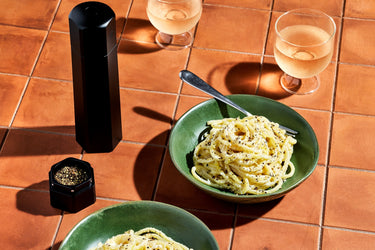6 Tips for Making the Perfect Cacio e Pepe

Cacio e pepe, the classic Roman pasta dish that highlights the flavors of pecorino and pepper, seems so dead-simple that it would be impossible to mess up. But as it turns out, sometimes the simplest dishes are the hardest to perfect. (By the way, the name translates to “cheese and pepper,” so there you go.)
When she was developing our HexClassic Cacio e Pepe recipe, seasoned food writer and interior designer Julia Heffelfinger created several versions before she nailed the texture of the perfect silky sauce. Her version of the sauce is made with only pasta water, aged Pecorino Romano, toasted black peppercorns and a touch of lemon zest.
“The recipe is the byproduct of lots and lots of testing, from the grating of the cheese to how to make the sauce,” she says. “That’s how I’d recommend for home cooks to get it down, too: Make it once or twice, then you’ll really get the technique.”
So that you can become a cacio e pepe perfectionist, here are Julia’s top six tips for making the dish.
1. Don’t Neglect Your Pepper
When you’re grinding pepper for the dish with your HexMill, you’re going to want a pretty coarse grind. Julia recommends toasting it in your 8" Hybrid Fry Pan so that it can release its floral and fruity notes.
“The texture and crunch of the pepper is just as important as the flavor,” Julia says. “I love that the HexMill gives you so much control over the size of the seasoning.”
2. Bucatini Is Best
Although you’ll often see spaghetti, as well as other noodles, made in the cacio e pepe style, Julia prefers bucatini for its heft and its bite.
“Because you’re going to toss the pasta vigorously to make the sauce, you want a denser noodle that’s not going to break apart,” she says.

3. Grab Your Grater
One of the elements Julia tested multiple times when developing the HexClassic Cacio e Pepe was how large to make the cheese. After first trying a microplane, she discovered that the small holes on a standard box grater deliver the best size of shaving so that the pecorino melts into the sauce. She even recommends grating the cheese in advance and letting it dry out in the fridge for a few hours before making the sauce. “Extra moisture is a wildcard factor and can give you clumps,” she says.
Choosing the right Pecorino Romano is important, too, since it’s the backbone of the sauce. Julia recommends going with one that’s aged at least 60 days so that it has a really pronounced, sharp flavor. For any non-pecorino fans out there, she recommends substituting half the cheese with an aged Parmigiano-Reggiano for a more mellow flavor.
4. Butter Isn't Always Better
Julia’s recipe completely eschews butter and cream, and although some cacio e pepe employs those rich ingredients, she thinks they’re a no-go. “Butter makes cacio e pepe kind of greasy and mellows the flavor of the cheese,” she says.
5. Step Away From the Stove
The key step of the HexClassic Cacio e Pepe is actually done off the stove. You’ll use some tepid reserved pasta water to create a slurry with grated pecorino and toasted pepper in a mixing bowl. Once your bucatini is cooked and drained, let it cool for about 30 seconds, because “pasta that’s too hot can make the sauce seize up,” Julia says. Then you’ll toss the pasta with the slurry, adding more pasta water as needed until you have an even, smooth coating.
“Tossing everything together on the stove makes it really easy to scorch your sauce, or you might have to add a ton of butter to get it silky,” Julia says.
6. Lemon Zest Works Wonders
Although traditional cacio e pepe recipes don’t use lemon, Julia adds a little zest to the sauce to brighten and freshen things up. Having friends over for dinner? She recommends grabbing a cocktail zester and garnishing the finished bowls of pasta with a few fancy twirls.
We know, we know. We’ll probably cacio you making this recipe again and again.





